Rain Barrels and Cisterns: What the Difference?
A rain barrel is an above ground storage system that collects and stores rainwater from your roof. This water can then be used to irrigate your lawn, wash your car, or water your garden. A rain barrel is usually created out of a single 55 gallon drum or several drums linked together. A cistern, on the other hand, is much larger and can hold hundreds to thousands of gallons of water. Cisterns are located either above or below ground. An above ground cistern is shown in Figure 1.
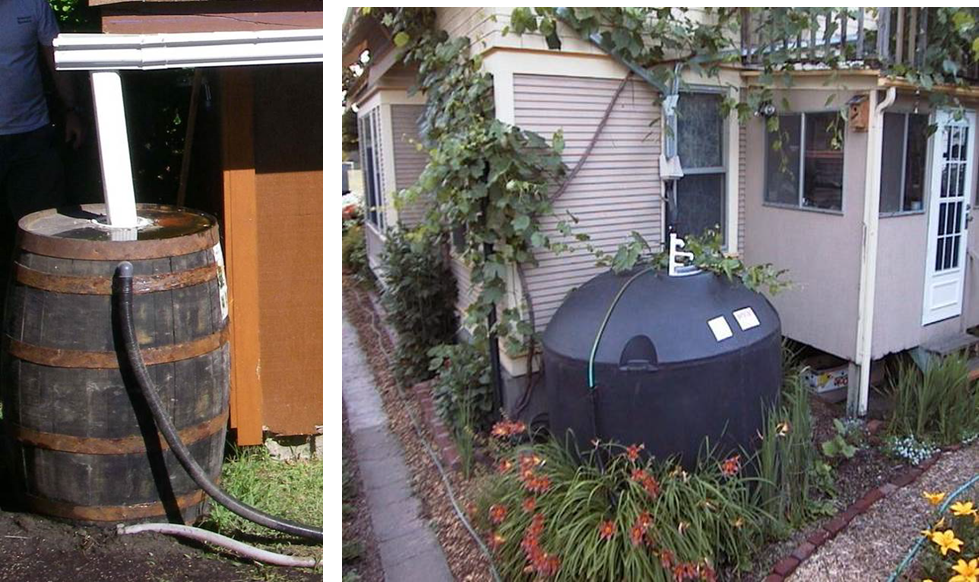
What are the benefits and disadvantages?
Storing rainwater aids in water conservation and also helps decrease water pollution by reducing stormwater runoff. Stormwater runoff is rain or snow melt that flows over roofs, driveways, sidewalks, lawns, or parking lots. When water flows over these surfaces it can pick up trash, sediment, motor oil, grease, bacteria (from human, pet, and wildlife waste), pesticides, and fertilizers. This water is then conveyed untreated to local waterbodies. By capturing and storing this water, the volume of polluted stormwater runoff conveyed to local waterbodies is decreased.
In terms of water conservation, it is estimated that during peak summer months, a rain barrel can save most homeowners 1,300 gallons of water. This decreased water use can result in a smaller water utility bill. Rain barrels also provide a free source of “soft water” that, unlike tap water, is free of chlorine, calcium, and lime. This water is ideal for watering gardens and flower pots and for window and car washing.
There are a couple minor disadvantages to using a rain barrel. One disadvantage is that a rain barrel does not provide pressurized water like a hose or tap does. Elevating the barrel on a sturdy platform, such as cement blocks, will increase the pressure and flow. Another disadvantage is that water collected by a rain barrel should not be used for drinking, cooking, or watering vegetables, herbs, or other edible plants. This is because many roofs are treated with chemicals to prevent algae and moss growth and many shingles have chemicals in them that may be washed off along with the rainwater.
How much water can be collected from my rooftop?
To determine your roof’s rainwater potential, calculate the square footage of your roof by measuring the perimeter of your house. Calculate only the part of your roof that drains into your downspout. This is called your “catchment area.” For every inch of rainwater that falls onto a catchment area of 1,000 square feet, you collect approximately 600 gallons of rain water. Even though an A-frame-style roof has more square feet of roofing than a flat roof, the amounts of rainwater collected are still the same for homes with the exact same perimeter dimensions. Amounts may be smaller if there is a heavy tree canopy over the roof. Use the figure below to calculate potential rainwater harvest based on your calculation of your housing perimeter.
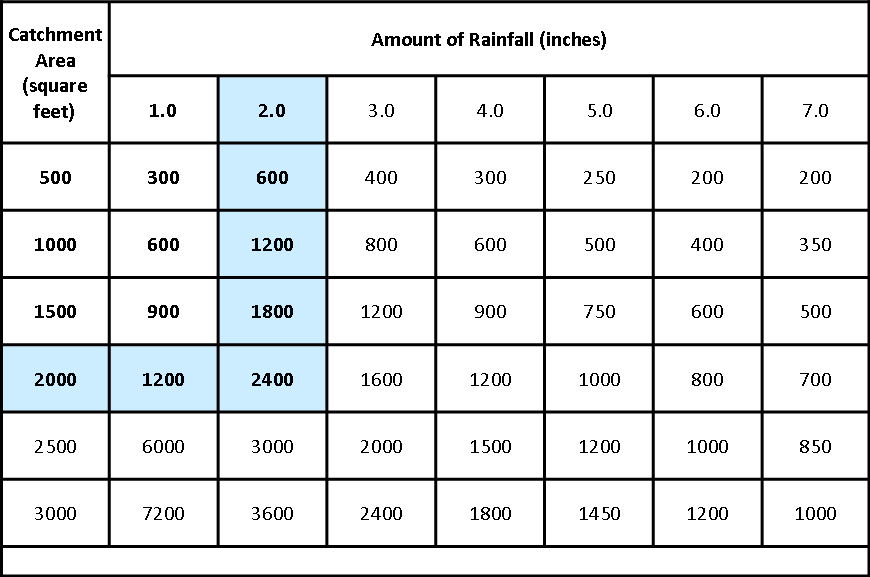
The highlighted areas show that two inches of rain falling on a catchment area of 2000 square feet will yield 2400 gallons of water. The same two inches of rainfall collected from 500 square feet of roof would yield 600 gallons. The amount of water collected (gal) assumes loss of one-third.
Rain Barrels
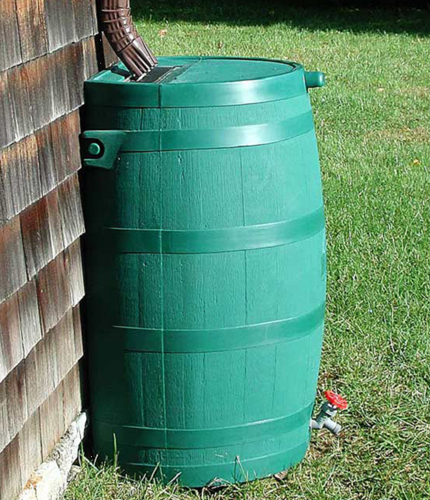
What types of rain barrels are available?
Rain barrels are available in a variety of materials, such as plastic, oak, titanium, and ceramic. Pre-made rain barrels can be purchased at home improvement stores; the cost is typically in the range of $100 to $300. The higher price range includes decorative containers that look like planters or ceramic vases. Low cost rain barrels are also sold by some Soil and Water Conservation Districts and watershed groups. You can also build your own rain barrel for as little as $10 to $25, depending on the tools and materials available to you.
Function and Components of a Rain Barrel
There are five basic components to a typical rain barrel: a removable lid, screen, overflow device, spigot, and a stand. A screen is built into the lid to keep out leaves and to prevent mosquitoes from getting into the barrel and breeding. The overflow device allows excess water to exit the barrel. An over-flow hose ( 3 in) can be use to direct the overflow water to a rain garden, flower garden, or other vegetated area. The barrel also requires a spigot that a garden hose can be attached to. The garden hose will be used to water after the rain event. The spigot can be on the side or bottom of the barrel. A stand of cement blocks may also be necessary if pressure is needed to drain the barrel. See Figure 1 A & B for two common variations.
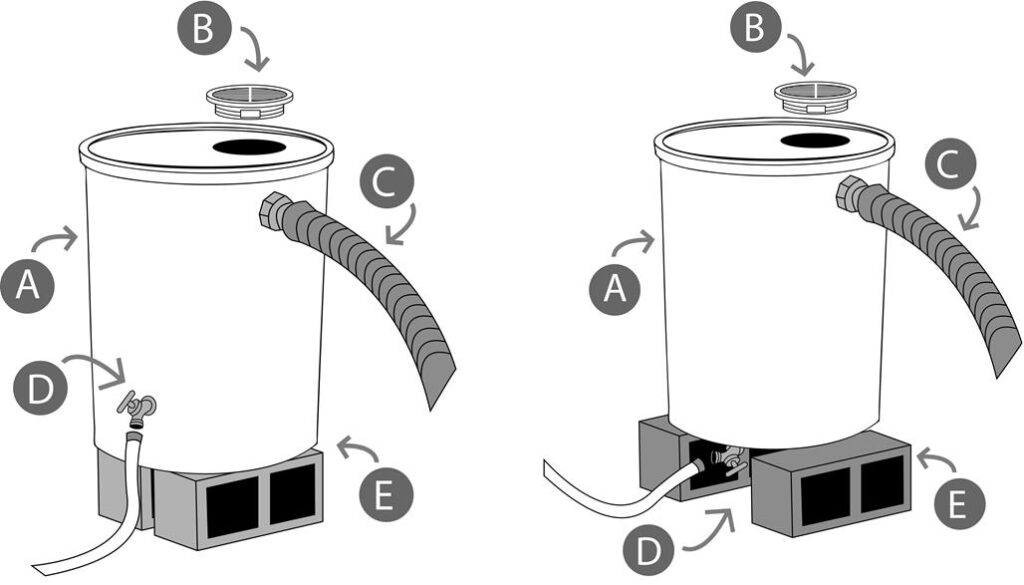
Rain Barrel Overflow Device
During a heavy rainstorm, a 55 gallon rain barrel will fill within minutes and begin to overflow, probably through the screen on the top of the barrel. An overflow device is necessary to divert excess water from the rain barrel to an area away from your home’s foundation. Excess water should be released at least 2 feet from a building without a foundation and at least 6 feet from a building with a foundation. The simplest thing to do is affix a tube to the upper portion of the rain barrel (approx three inches below the top of the barrel). To be effective, the overflow tube must be able to keep up with the rate of water flowing into the barrel. Usually a ¾ inch garden hose will not accommodate heavy rain events.
How do I build a rain barrel?
Rain barrels can be made out of any type of water-proof container that is strong enough to hold large capacities of water without warping or tipping over. However, it is strongly recommended that you use a container that is food grade material in order to prevent leaching of chemicals. There are many excellent step-by-step instructions on-line for building a rain barrel. Multiple video demonstrations can also be found. Here are a couple links to videos on YouTube:
http://www.finegardening.com/how-to/videos/build-a-rain-barrel.aspx and http://www.youtube.com/watch?v=MGFDlkJOdaM
Important things you should know:
- Use a tight-fitting lid to keep out children and animals. A depth of 6 inches of standing water can be a hazard, the opening in the lid should be 4 inches or less.
- Avoid translucent plastic barrels. They allow enough light into the barrel to let algae grow. Additionally, direct sunlight can shorten the life of plastic and age some finishes.
- There is some controversy regarding the use of harvested rainwater for watering vegetables since bird droppings, some roofing materials and air pollutions can accumulate in the water. It is better to be on the safe side and use the rain barrel water only for lawns and ornamentals. In detail, roofs may leach toxins from materials such as old tar, asbestos shingles, terne-coated stainless steel, lead solder, or treated wood. Additionally, roofs can cultivate growth of mold or bacteria through wood shakes, clay tiles, or asphalt shingles. However, your roof material is inconsequential if the water is simply going to be used to water your lawn or flowers.
- Your rain barrel should be regularly inspected and maintained. Clean all parts of the barrel and check for leaks at least once a year. The screen can get clogged with debris so it should be cleaned two to three times a year. Before winter, drain and disconnect the rain barrel, as a frozen rain barrel can become disfigured and unsteady. In addition to maintaining the rain barrel itself, remember to also maintain your rain gutters, which should be cleaned out at least twice a year.
Cisterns
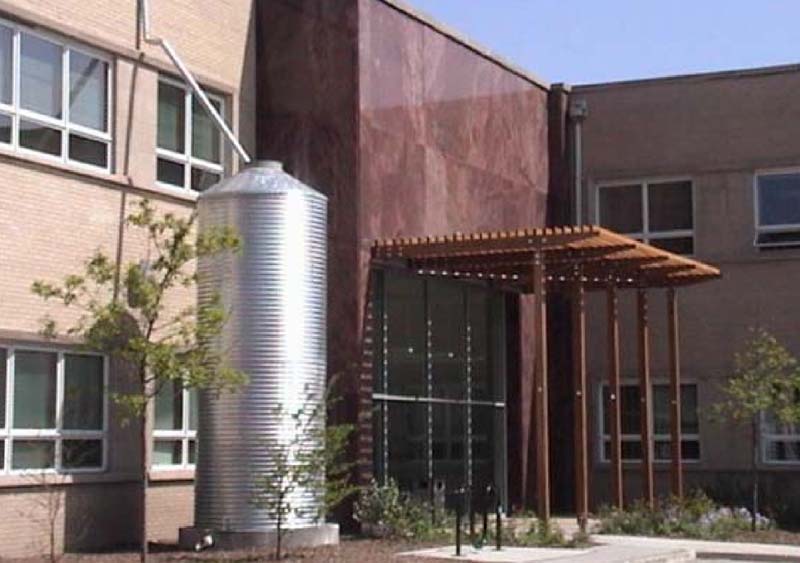
When a rain barrel is too small to collect the necessary amount of water, a cistern may be a better option. Cisterns function similarly to rain barrels and have the same benefits, except they hold a larger quantity of water. A cistern can range in size from 500 – 10,000 gallons. Cisterns are sealed to reduce risks to children, algae growth, and mosquito breeding. Water can be discharged from the cistern by gravity, a pump, or pressurized distribution.
A single large cistern can collect water from multiple downspouts and/or multiple roofs. Avoid connecting cistern drains with sewer lines in order to avoid backflow contamination. Dealing with such as large volume of water necessitates a good overflow system that allows roof runoff to safely soak into the ground and not discharge into the stormwater system.
What types of cisterns are available?
Three main types of cisterns exist: above ground, partially buried, and underground. They are commonly constructed of fiberglass, brick, concrete, plastic, or wood and typically contain the following components: secure and solid cover, leaf/mosquito screen at cistern entrance, coarse inlet filter with clean out valve, overflow pipe; manhole, sump, and drain to facilitate cleaning, and water use spigot. Additional features may include: a device to indicate the amount of water in the tank, a sediment trap.
How do I determine the size of cistern I’ll need?
Deciding on which cistern to buy will depend on the amount of runoff your home/building generates, water use, and cost. To determine the cistern size you will need, use the following equation:
Volume (V) = Water Quality Volume(WQv) * 7.5 gallons/ft3
Where:
Volume = Volume of system in gallons
WQv = Water Quality Volume (ft3)
7.5 = Conversion factor (gallons per ft3
To obtain WQv, use the following equation:
WQv = (P)(Rv)(A)/12
Where: P = 90% rainfall number, which equals 0.9 inches
Rv = 0.05+0.009 (I) = 0.05+0.009(100) = 0.95
I = the percentage of impervious area draining to site, which would be 100% for a cistern
A = the Area Draining to the Practice
Example: Given a 1,000 square foot impervious surface area draining to a cistern, calculate the water quality volume and required storage volume within the system.
Step 1: Calculate water quality volume using the following equation:
WQv = (0.9) (0.95) (1,000ft2)/12
= 71.25 ft3
Step 2: Calculate storage volume using equation above: Vol = (WQv) (7.5 gallons/ft3)
Vol = 71.25 ft3 * 7.5 gals/ft3
= 534 gallons
What are the costs?
Cistern costs vary based on material and installation. Table 2 shows the cost of 4 different cistern systems. The costs below do not include installation.
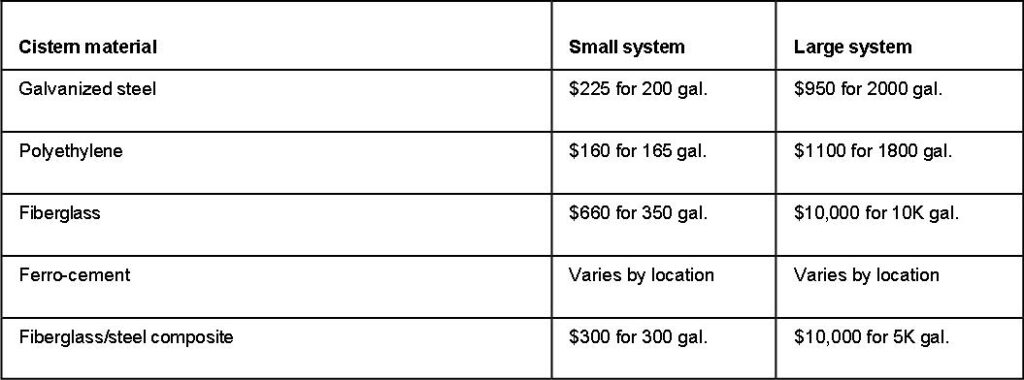
Source: The Low Impact Development Center, Inc. (http://www.lowimpactdevelopment.org/ffxcty/7-1_rainbarrel_draft.pdf)
What is a first flush diverter and should I have one?
First flush diverters capture the first few gallons of roof runoff and divert it away from the cistern. Diverting the first flush of water helps to reduce the amount of pollutants in the water collected by the cistern, thereby improving water quality. It has been shown that first flush diverters remove up to 80% of the pollutants that collect on the roof or in the gutters and become dissolved or suspended in the cistern water when it rains. A first flush diverter is important to have if you are planning on treating the water for drinking or cooking.
Is it possible to treat rainwater so that it can be used for drinking and cooking?
Yes, however, your state and/or local heath department has to approve.
Treating rainwater requires a filtration and disinfection system to ensure that parasites, bacteria, insects, and toxins (heavy metals, algaecides, etc) leached from the roofing system are removed.